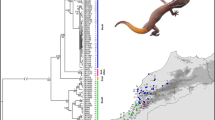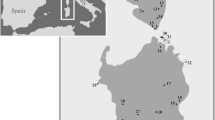Abstract
Vicariance and isolation leading to speciation of reptiles on islands is well exemplified in a number of taxa in the Caribbean. The St. Lucia whiptail (Cnemidophorus vanzoi), considered a single species, is found on two small islets (Maria Major and Maria Minor) off the main island of St. Lucia. From lizards collected from both localities, we gathered morphological measurements and analysed the genetic divergence between populations, using a molecular survey of ∼ ∼2800 mtDNA base pairs and 8 microsatellites. There are significant differences in body size and general form and fixed but small mtDNA differences between island populations. Microsatellites reveal low diversity within populations but very high differentiation between islands with non-overlapping allele size ranges at all except one microsatellite and two loci exhibiting single-base polymorphism, fixed between islands. Based on these results, we examine published criteria to determine whether the studied island forms could be considered true species. According to the phylogenetic species concept and Moritz’s evolutionary significant unit (ESU) criteria, the two lizard populations can be considered separate entities. Crandall et al.’s (2000, Trends Ecol. Evol., 15, 290–295) broader categorization of population distinctiveness, based on concepts of ecological and genetic exchangeability, produces conflicting results depending on the interpretation of the observed ecological data. Following Fraser and Bernatchez’s (2001, Mol. Ecol., 10, 2741–2752) framework for management decisions when ecological data are not sufficient we propose that the lizard populations on the Maria islands are on differing evolutionary trajectories and thus at the species boundary. The populations are of high priority to conservation, thus meriting separate management.
Similar content being viewed by others
References
Anthony D (1993) The ecology of the Maria Island ground lizard. MSc thesis, University of Kent
Baric S, Sturmbauer C (1999) Ecological parallelism and cryptic species in the genus Ophiothrix derived from mitochondrial DNA sequences. Molecular Phylogenetics and Evolution 11:157–162
Baskin JN, Williams EE (1966) The Lesser Antillean Ameiva. Stud. Fauna Curacao and Carib. Is. 89:143–176
Bond JE, Sierwald P (2002) Cryptic speciation in the Anadenobolus excisus millipede species complex on the Island of Jamaica. Evolution 13:1123–1135
Bowcock AM, Ruiz-Linares A, Tomfohrde J, et al. (1994) High-resolution of human evolutionary trees with polymorphic microsatellites. Nature 368:455–457
Buley K, Prior KA, Gibson RC (1997) In search of the St. Lucia racer, Liophis ornatus, with further observations on the reptile fauna of the Maria Islands, St. Lucia, West Indies. Dodo 33:104–117
Cockerham CC, Weir BS (1993) Estimation of gene flow from F-statistics. Evolution 47:855–863
Cracraft J (1989) Speciation and its ontology: The empirical consequences of alternative species concepts for understanding patterns and processes of differentiation. In: Otte D, Endler JA. (eds), Speciation and its consequences. Sinauer Associates Inc, Sunderland MA
Crandall KA, Bininda-Emonds ORP, Mace GM, Wayne RK (2000) Considering evolutionary processes in conservation biology. Trends in Ecology & Evolution 15:290–295
Davis JI, Nixon KC (1992) Populations, genetic variation, and the delimitation of phylogenetic species. Systematic Biology 41:421–435
Dickinson HC, Fa JE (2000) Abundance, demographics and body condition of a translocated population of St Lucia whiptail lizards (Cnemidophorus vanzoi). Journal of Zoology (London) 251:187–197
Dickinson HC, Fa JE, Lenton SM (2001) Microhabitat use by a translocated population of St Lucia whiptail lizards (Cnemidophorus vanzoi). Animal Conservation 4:143–156
Forstner MRJ, Davis SK, Arévalo E (1995) Support for the hypothesis of anguimorph ancestry for the suborder serpentes from phylogenetic analysis of mitochondrial DNA sequences. Molecular Phylogenetics and Evolution 4:93–102
Forstner MRJ, Dixon JR, Forstner JM, Davis SK (1998) Apparent hybridization between Cnemidophorus gularis and Cnemidophorus septemvittatus from an area of sympatry in Southwest Texas. Journal of Herpetology 32:418–425
Fraser DJ, Bernatchez L (2001) Adaptive evolutionary conservation: towards a unified concept for defining conservation units. Molecular Ecology 10:2741–2752
Fu JZ (2000) Toward the phylogeny of the family Lacteridae – Why 4708 base pairs of mtDNA sequences cannot draw the picture. Biol. J. Soc., 71:203–217
Gifford ME, Powell R, Larson A, Gutberlet Jr RL (2004) Population structure and history of a phenotypically variable teiid lizard (Ameiva chrysolaema) from Hispaniola: the influence of a geologically complex island. Molecular Phylogenetics and Evolution 32:735–748
Glor RE, Kolbe JJ, Powell, R, Larson, A, Losos, JB (2003) A comparative analysis of morphological diversification in Hispaniolan trunk-ground anoles (Anolis cybotes group). Evolution 57:2383–2397
Goldstein PZ, DeSalle R, Amato G, Vogler AP (2000) Conservation genetics at the species boundary. Conservation Biology 14:120–131
Gottelli D, Marino J, Sillero-Zubiri C, Funk SM (2004) The effect of the last glacial age on speciation and population genetic structure of the endangered Ethiopian wolf (Canis simensis). Molecular Ecology 13:2275–2286
Hower LM, Hedges SB (2003) Molecular phylogeny and biogeography of West Indian Teiid lizards of the genus Ameiva. Caribbean Journal of Science 39:298–306
Hudson RR, Boos DD, Kaplan NL (1992) A statistical test for detecting geographic subdivision. Molecular Biology and Evolution 9:138–151
Ihaka R, Gentleman R (1996) R: a language for data analysis and graphics. Journal of Computational and Graphical Statistics 5:299–314
IUCN (1987) The IUCN position statement on translocation of living organisms: introductions, re-introductions and re-stocking International Union for the Conservation of Nature (IUCN), Gland
Kocher TD, Thomas WK, Meyer A, et al. (1989) Dynamics of mitochondrial-DNA evolution in animals -amplification and sequencing with conserved primers. Proceedings of the National Academy of Science of the United States of America 86:6196–6200
Madsen T, Shine R, Olsson M, Wittzell H (1999) Restoration of an inbred adder population. Nature 402:34–35
Miles DB, Dunham AE (1992) Comparative analyses of phylogenetic effects in the life-history patterns of iguanid reptiles. Am. Nat. 139, 848–869
Moritz C (1994) Defining ‘Evolutionary Significant Units’ for conservation. Trends in Ecology & Evolution 9:373–375
Pritchard JK, Stephens M, Donnelly P (2000) Inference of population structure using multilocus genotype data. Genetics 155:945–959
Radtkey RR, Fallon SM, Case TJ (1997) Character displacement in some Cnemidophorus lizards revisited: A phylogenetic analysis. Proceedings of the National Academy of Science of the United States of America 94:9740–9745
Raymond M, Rousset F (1995) GENEPOP (version 1.2): Population genetics software for exact tests and ecumenicism. J. Hered., 86:248–249
Reeder TW (1995) Phylogenetic relationships among phrynosomatid lizards as inferred from mitochondrial ribosomal DNA sequences: substitution bias and information content of transitions relative to transversions. Molecular Phylogenetics and Evolution 4:203–222
Reeder TW, Cole CJ, Dessauer HC (2002) Phylogenetic Relationships of Whiptail Lizards of the Genus Cnemidophorus (Squamata: Teiidae): A Test of Monophyly, Reevaluation of Karyotypic Evolution, and Review of Hybrid Origins. American Museum Novitates 3365:1–61
Ryder O.A. (1986) Species conservation and systematics: the dilemma of subspecies. Trends in Ecology & Evolution 1:9–10
Rice WR (1989) Analysing tables of statistical tests. Evolution 43:223–225
Rowe G, Dickinson HC, Gibson R, Funk SM, Fa JE (2002) St Lucia Whiptail Lizard Cnemidophorus vanzoi (Sauria:Teiidae) microsatellite primers. Molecular Ecology Notes 2:124–126
Templeton AR (1989) The meaning of species and speciation: a genetic perspective. In: Otte D, Endler JA. (eds), Speciation and its Consequences. Sinauer, Sunderland, MA, pp. 3–27
Templeton AR (1998) Species and Speciation: Geography, population structure, ecology and gene trees. In: Howard DJ, Berlocher SA (eds), Endless forms: species and speciation. Oxford University Press, New York, pp. 32–43
Tracy CR (1999) Differences in body size among chuckwalla (Sauromalus obesus) populations. Ecology 80:259–271
Vitt LJ, Breitenbach GL (1993) Life Histories and reproductive tactics among lizards in the genus Cnemidophorus (Sauria: Teiidae). In: Biology of the Whiptail Lizard (Genus Cnemidophorus)(eds. Wright JW, Vitt LJ) pp. 211–239. Herpetology League Spec. Publ. No. 3, Norman, OK
Walsh PS, Metzger DA, Higuchi R (1991) Chelex 100 as a medium for simple extraction of DNA for PCR based typing from forensic material. BioTechniques 10:506–513
Wikelski M, Romero LM (2003) Body size, performance and fitness in Galapagos marine iguanas. Integrative and Comparative Biology 43:376–386
Wilson BS (1991) Latitudinal variation in activity season mortality rates of the lizard Uta stansburiana. Ecological Monographs 61:393–414
Wyner Y, Absher R, Amato G, et al. (1999) Species concepts and the determination of historic gene flow patterns in the Eulemur fulvus (Brown Lemur) complex. Biological Journal of the Linnean Society 66:39–56
Acknowledgements
We thank Hanna Dickinson and Kevin Buley for providing Maria Minor samples and Maria Major reference samples and for comments. We are grateful to Steven Ormond and Donald Anthony for help in the field. The St. Lucia Government is gratefully acknowledged for granting permission to work in the Maria Islands. The Institute of Zoology, ZSL, London, provided laboratory facilities and support for molecular analyses. Helpful comments on the manuscript were received from two anonymous referees.
Author information
Authors and Affiliations
Corresponding author
Rights and permissions
About this article
Cite this article
Funk, S.M., Fa, J.E. Phylogeography of the endemic St. Lucia whiptail lizard Cnemidophorus vanzoi: Conservation genetics at the species boundary. Conserv Genet 7, 651–663 (2006). https://doi.org/10.1007/s10592-005-9068-7
Received:
Accepted:
Published:
Issue Date:
DOI: https://doi.org/10.1007/s10592-005-9068-7




